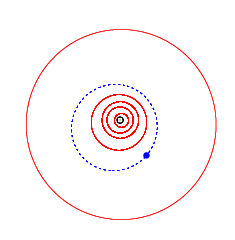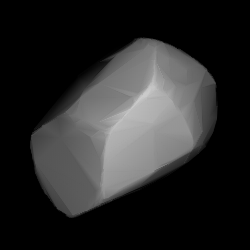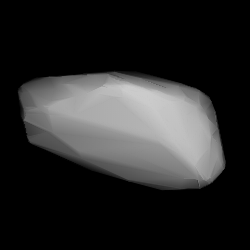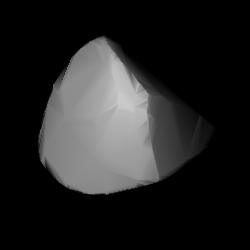Related Research Articles

7166 Kennedy, provisional designation 1985 TR, is a stony Nysian asteroid from the inner regions of the asteroid belt, approximately 5 kilometers in diameter. It was discovered on 15 October 1985, by American astronomer Edward Bowell at Lowell's Anderson Mesa Station near Flagstaff, Arizona, in the United States. The asteroid was named after Malcolm Kennedy of the Astronomical Society of Glasgow.

(9948) 1990 QB2 (provisional designation 1990 QB2) is a stony Nysian asteroid from the inner region of the asteroid belt, approximately 3.4 kilometers (2.1 miles) in diameter. It was discovered on 22 August 1990, by American astronomer Henry Holt at the Palomar Observatory in California. The likely elongated S-type asteroid has a rotation period of 3.53 hours. This asteroid has not been named.
2751 Campbell, provisional designation 1962 RP, is a stony Nysian asteroid from the inner regions of the asteroid belt, approximately 6 kilometers in diameter.
9916 Kibirev, provisional designation 1978 TR2, is a Koronian asteroid from the outer regions of the asteroid belt, approximately 6 kilometers (3.7 miles) in diameter. It was discovered on 3 October 1978, by astronomer Nikolai Chernykh at the Crimean Astrophysical Observatory in Nauchnij, on the Crimean peninsula. The likely S-type asteroid has a rotation period of about 15.2 hours and was named after Russian informatician Sergej Kibirev.
4797 Ako, provisional designation 1989 SJ, is a stony Nysian asteroid from the inner regions of the asteroid belt, approximately 5 kilometers in diameter. It was discovered on 30 September 1989, by the Japanese astronomers Toshiro Nomura and Kōyō Kawanishi at the Minami-Oda Observatory, Japan. The asteroid was named for the Japanese city of Akō.

10656 Albrecht is a carbonaceous background asteroid from the outer region of the asteroid belt, approximately 10 kilometers in diameter. It was named after German astronomer Carl Theodor Albrecht.
7553 Buie, provisional designation 1981 FG, is a Nysa asteroid from the inner regions of the asteroid belt, approximately 3.5 kilometers in diameter. It was discovered on 30 March 1981, by American astronomer Edward Bowell at Lowell's Anderson Mesa Station near Flagstaff, Arizona. The stony S-type asteroid has a rotation period 4.2 hours an possibly an elongated shape. It was named after American astronomer Marc Buie.
2325 Chernykh, provisional designation 1979 SP, is a dark Themistian asteroid from the outer regions of the asteroid belt, approximately 23 kilometers in diameter. It was discovered on 25 September 1979, by Czech astronomer Antonín Mrkos at the Klet Observatory in the Czech Republic. The asteroid was named after Russian astronomer couple Lyudmila Chernykh and Nikolai Chernykh.

4429 Chinmoy, provisional designation 1978 RJ2, is a Nysian asteroid from the inner regions of the asteroid belt, approximately 3.5 kilometers (2.2 miles) in diameter. It was discovered on 12 September 1978, by Soviet astronomer Nikolai Chernykh at the Crimean Astrophysical Observatory in Nauchnij, on the Crimean Peninsula. The likely S-type asteroid was named after Indian spiritual leader Sri Chinmoy.

1275 Cimbria is a Eunomia asteroid from the central regions of the asteroid belt, approximately 27 kilometers in diameter. It was discovered on 30 November 1932, by astronomer Karl Reinmuth at the Heidelberg-Königstuhl State Observatory in southern Germany. The asteroid was named after the Cimbri, an ancient Germanic tribe.
14789 GAISh, provisional designation 1969 TY1, is a dark background asteroid from the outer regions of the asteroid belt, approximately 15 kilometers (9 miles) in diameter. It was discovered on 8 October 1969, by Soviet astronomer Lyudmila Chernykh of the Crimean Astrophysical Observatory at Nauchnij, on the Crimean peninsula. The assumed C-type asteroid has a rotation period of 8.1 hours and possibly an elongated shape. It was named for the Russian Sternberg Astronomical Institute (GAISh) of Moscow State University.
2537 Gilmore, provisional designation 1951 RL, is a Eunomia asteroid from the middle region of the asteroid belt, approximately 7 kilometers in diameter. It was discovered on 4 September 1951, by German astronomer Karl Reinmuth at Heidelberg Observatory in southern Germany. It was named after New Zealand astronomer couple Alan C. Gilmore and Pamela M. Kilmartin
6395 Hilliard, provisional designation 1990 UE1, is a stony Nysian asteroid from the inner regions of the asteroid belt, approximately 4.5 kilometers in diameter.
23718 Horgos (provisional designation 1998 GO10) is a stony background asteroid from the central regions of the asteroid belt, approximately 2.9 kilometers in diameter. It was discovered on 2 April 1998, by Hungarian astronomers Krisztián Sárneczky and László Kiss at Konkoly's Piszkéstető Station northeast of Budapest, Hungary. The asteroid was named after the Serbian town of Horgoš.

6546 Kaye (prov. designation: 1987 DY4) is a dark and elongated background asteroid from the outer region of the asteroid belt. It was discovered on 24 February 1987, by Czech astronomer Antonín Mrkos at the South Bohemian Kleť Observatory in the Czech Republic. The presumed C-type asteroid has a rotation period of 10.0 hours and measures approximately 22 kilometers (14 miles) in diameter. It was named for American actor Danny Kaye.
2726 Kotelnikov, provisional designation 1979 SE9, is a stony Koronian asteroid from the outer regions of the asteroid belt, approximately 10 kilometers (6.2 miles) in diameter. It was discovered on 22 September 1979, by Soviet astronomer Nikolai Chernykh at the Crimean Astrophysical Observatory in Nauchnij on the Crimean peninsula. The S-type asteroid has a rotation period of 4.91 hours and is a suspected binary system. The asteroid was named for Soviet scientist and pioneer in radar astronomy, Vladimir Kotelnikov.
1303 Luthera, provisional designation 1928 FP, is a dark asteroid and the parent body of the Luthera family, located in the outermost regions of the asteroid belt. It measures approximately 90 kilometers in diameter. The asteroid was discovered on 16 March 1928, by astronomer Friedrich Schwassmann at the Bergedorf Observatory in Hamburg, Germany, and later named after German astronomer Robert Luther.
7866 Sicoli, provisional designation 1982 TK, is a stony Nysa asteroid from the inner regions of the asteroid belt, approximately 6 kilometers in diameter. It was discovered on 13 October 1982, by American astronomer Edward Bowell at Lowell's Anderson Mesa Station near Flagstaff, Arizona. The asteroid was named after Italian astronomer Piero Sicoli.

3962 Valyaev is a dark Themistian asteroid from the outer region of the asteroid belt. The presumed C-type asteroid has a rotation period of 16.4 hours and measures approximately 15 kilometers in diameter. It was discovered on 8 February 1967, by Russian astronomer Tamara Smirnova at Nauchnyj on the Crimean peninsula, and later named after Russian astronomer Valerij Valyaev.
4760 Jia-xiang, provisional designation 1981 GN1, is a background asteroid from the inner regions of the asteroid belt, approximately 5 kilometers (3 miles) in diameter. It was discovered on 1 April 1981, by astronomers at Harvard University's Oak Ridge Observatory in Massachusetts, United States. The presumed stony S-type asteroid was named after Chinese astronomer Zhang Jiaxiang. It has a rotation period of 14.96 hours.
References
- 1 2 3 4 5 6 7 "21795 Masi (1999 SN9)". Minor Planet Center. Retrieved 29 May 2018.
- 1 2 3 4 "JPL Small-Body Database Browser: 21795 Masi (1999 SN9)" (2017-09-27 last obs.). Jet Propulsion Laboratory . Retrieved 29 May 2018.
- 1 2 "Asteroid 21795 Masi". Small Bodies Data Ferret. Retrieved 29 May 2018.
- 1 2 3 4 5 6 7 "LCDB Data for (21795) Masi". Asteroid Lightcurve Database (LCDB). Retrieved 29 May 2018.
- 1 2 3 Masiero, Joseph R.; Mainzer, A. K.; Grav, T.; Bauer, J. M.; Cutri, R. M.; Dailey, J.; et al. (November 2011). "Main Belt Asteroids with WISE/NEOWISE. I. Preliminary Albedos and Diameters". The Astrophysical Journal. 741 (2): 20. arXiv: 1109.4096 . Bibcode:2011ApJ...741...68M. doi:10.1088/0004-637X/741/2/68.
- 1 2 3 4 Mainzer, A.; Grav, T.; Masiero, J.; Hand, E.; Bauer, J.; Tholen, D.; et al. (November 2011). "NEOWISE Studies of Spectrophotometrically Classified Asteroids: Preliminary Results". The Astrophysical Journal. 741 (2): 25. arXiv: 1109.6407 . Bibcode:2011ApJ...741...90M. doi:10.1088/0004-637X/741/2/90. (catalog)
- 1 2 3 Waszczak, Adam; Chang, Chan-Kao; Ofek, Eran O.; Laher, Russ; Masci, Frank; Levitan, David; et al. (September 2015). "Asteroid Light Curves from the Palomar Transient Factory Survey: Rotation Periods and Phase Functions from Sparse Photometry". The Astronomical Journal. 150 (3): 35. arXiv: 1504.04041 . Bibcode:2015AJ....150...75W. doi:10.1088/0004-6256/150/3/75.
- ↑ Veres, Peter; Jedicke, Robert; Fitzsimmons, Alan; Denneau, Larry; Granvik, Mikael; Bolin, Bryce; et al. (November 2015). "Absolute magnitudes and slope parameters for 250,000 asteroids observed by Pan-STARRS PS1 - Preliminary results". Icarus. 261: 34–47. arXiv: 1506.00762 . Bibcode:2015Icar..261...34V. doi:10.1016/j.icarus.2015.08.007.
- 1 2 Nesvorný, D.; Broz, M.; Carruba, V. (December 2014). "Identification and Dynamical Properties of Asteroid Families". Asteroids IV. pp. 297–321. arXiv: 1502.01628 . Bibcode:2015aste.book..297N. doi:10.2458/azu_uapress_9780816532131-ch016. ISBN 9780816532131.
- ↑ "MPC/MPO/MPS Archive". Minor Planet Center. Retrieved 29 May 2018.